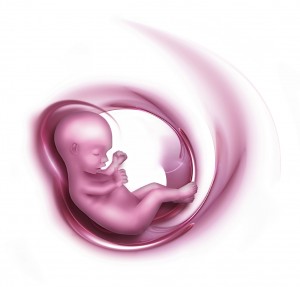
The placenta is the organ that a pregnant woman develops inside her uterus, to transfer oxygen and nutrients to her baby via the blood, while removing gasses and other waste from the infant. Researchers once thought that the placenta was a “sterile” environment, devoid of any bacteria that might find its way to the growing baby attached by the umbilical cord. But a new study has uncovered that the placenta actually harbors hundreds of bacteria species; most of them are harmless or beneficial.
Scientists found about 300 types of bacteria; they then compared the distribution of bacteria types with those that had been found previously in other parts of mothers’ bodies, including the mouth, skin, gut and vagina.
The study found that the bacterial make-up of the placenta most closely resembled a mother’s mouth bacteria. A mother’s mouth flora, in turn, most closely resemble a baby’s gut flora in the first week after birth.
The numbers of bacteria in the placenta were comparable to those in the eyes or deeper layers of skin (less than 10 percent by mass), but many times fewer than the number of biota in an intestine; biota is the term used to refer to all bacteria, fungi and viruses present in a normal gut.
The team collected placentas from 320 deliveries; most of the births had been full-term, but some were premature. Most of the babies had been born vaginally, but some had been born through Caesarean section.
Recently, it had been assumed that babies picked up much of their beneficial gut bacteria during vaginal delivery, so, it was expected that the mother’s vaginal bacteria make-up would resemble her infant’s gut bacteria, at least soon after birth. But researchers in the above study saw that in previous studies, a mother’s vaginal flora was not similar to that present in a newborn’s intestine; they began to wonder if there might not be other sources for the baby’s initial gut bacteria, other than vaginal bacteria picked up during birth.
Lead study author Dr. Kjersti Aagaard, of the Baylor College of Medicine in Houston, TX, also noted that babies are born covered with a waxy substance called vernix, which, if anything, would discourage bacteria from attaching to the baby as it comes through the birth canal.
The study, which was recently published in Science Translational Medicine, is likely to modify medical perceptions of how to best treat pregnant women with such medications as antibiotics, in view of the fact that those kill friendly bacteria in the mother, and according to the Baylor study, they would also affect what bacteria get transferred from mother to baby.
Dr. Aagaard and her study colleagues suspect that during pregnancy, the wrong mix of bacteria reaching the fetus could contribute to premature births. That may help explain why gum disease and urinary tract infections are both linked to a greater risk of premature birth. Doctors advise women looking to conceive to treat any existing gum disease before pregnancy; as for urinary tract infections, many people have excellent, full recovery by drinking 3 or 4 16-ounce glasses of cranberry juice a day for three days straight.
Jamell Andrews